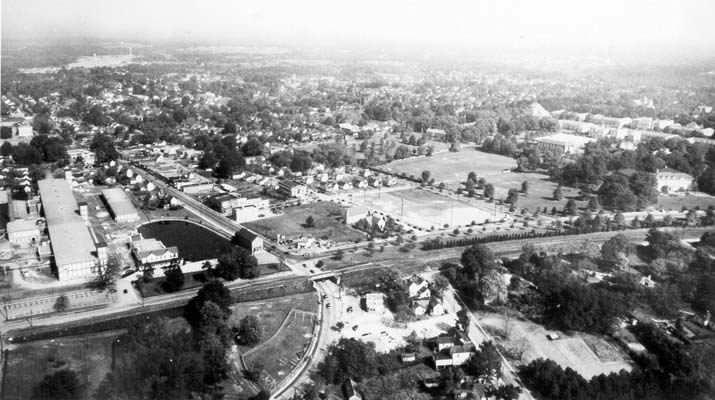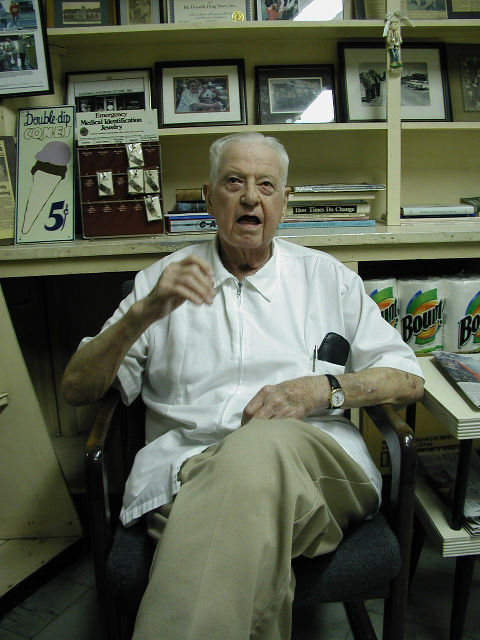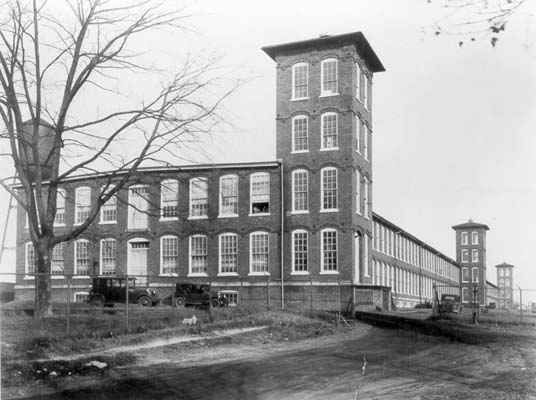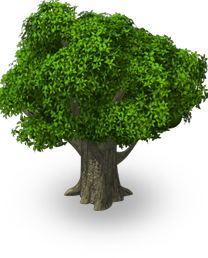John McDonald: This Old Drugstore
McDonald's Drugstore has been on Ninth Street in Durham for more than 80 years. When I interviewed John McDonald, I asked him how things had changed over all that time. I guess I expected him to lay into the chain stores that have taken over the pharmacy business or to feel uneasy about the new tattoo and body-piercing parlor next door.
Ninth Street Looking North (ca. 1930): Aerial photo shows railroad overpass just south of Ninth Street on Erwin Road. You can still see a fairly undeveloped area to the north and Duke's East Campus (far right).
Instead, he looked around the old pharmacy, with its antique soda fountain and soothing blue bottles of Hunter's Sarspirilla and Cow Balm, and he said, matter of factly: "See that south wall? When I was little, there used to be a booth there."
Not much has changed at McDonald's Drugstore. Six days a week, John and Frances McDonald still greet children with warm smiles and the best milkshakes and vanilla Cokes in town. The dress shop owner next door knows to go behind the counter and help herself, and the walls are adorned with hundreds of school photos, mementos from customers whose families have been coming to McDonald's for generations.
Their drugstore might not carry every gewgaw that you can buy at a shopping mall or chain store. But as I watched a crowd of gleeful children sipping orangeades while an older woman chatted with Mrs. McDonald about her granddaughter's piano recital, I got the feeling that maybe their customers were coming there for things that money can't buy.
* * *

John McDonald.
I was brought up in the drugstore. My father opened in 1914 on Main Street. He moved to Ninth Street in 1916 in a two-story wooden building. He moved in this location in 1922. I went to school at E.K. Powe, two blocks down the street here. When I was big enough, instead of walking home, I'd walk down to the drugstore. I'd sit over in the booth there and do my homework.
West Durham was a little community by itself, basically involved with Erwin Mills, which made sheets and pillow cases. The small stores up and down Ninth Street provided for the needs mostly of the people that worked for Erwin Mills. You had a couple little barber shops, a couple little shoe shops, a couple grocery stores.
Most of the recreation was provided by Erwin Auditorium, which was owned by the mill. They had an indoor swimming pool, a bowling alley, a soda shop, a library, a tennis court. This whole field up here where Wellspring Grocery is now was a baseball field. And they had movies three nights a week at the auditorium. Basically, everybody stayed pretty much in West Durham, and most people knew each other.
Things were so quiet, people left their front doors open. They didn't lock up anything. When I was delivering, a lot of times I'd go bang at the front door, maybe seven or eight o'clock at night. Wasn't anybody coming to answer, I'd just open the door and put the prescriptions on the kitchen table and walk out and go on about my business.
During the Great Depression, things were not going well financially for anyone. Families were a little larger in those days, and not enough income. Quite often, people would come down to the drugstore and say, "Doc, I've got some sick children. I just don't have the money right now. Can you fill these prescriptions and let me pay you when I can?" And my father did.
They were hard times. It was very difficult, because he was having to pay his suppliers. For a long time, I kept some checks on the Bank of West Durham, which was two doors down from us and went under during the Depression. Checks were returned for as little as $1.25 and $1.50 for insufficient funds. I kept them as mementoes of harder days.

When I got out of high school in 1938, I got a job at Erwin Mills and was living home and saving my money. I made the sum total of $11.88 a week. Strangely enough, even weavers and loom fixers-adults-were making $14 to $15 a week. They weren't high paid either. The big majority of the people lived in mill houses, which were all around the area. I worked there about 15 months, then I went on to the University of North Carolina.
Back in those days, doctors made house calls. They'd go see patients at Watts Hospital, which is about 4 blocks up from here. At night, after they finished their hospital rounds, they'd come out around the community. If someone had a sick child, they'd call his office and he'd go by.
Quite often, the people, knowing the doctor was in the neighborhood, they'd send a friend over and say, "Listen, we've got a sick child here." So they'd make house calls around the neighborhood, then call the prescriptions in, and we would deliver them on a bicycle. I don't know many pharmacies that do that anymore!
Fifty years ago, when I first got my pharmacy license, I knew most of the people in the community and their families. You saw people in all stages of life. You saw the happy side of life-the babies, the new births-and you saw the sad part, when people were sick with fatal diseases.
The children stayed pretty much in the neighborhood. Many would follow the family into the mill. When a lot of them got married, they just moved three or four blocks away. If you had given good service to the parents, then you inherited another family. You built your business on your past experiences. It was very pleasant.
Now most of the people we wait on are strangers, because this area is more transient now. We have a few regular customers, but not nearly as many as we used to have. Like the pharmacists, they're kind of disappearing.
Years ago, people would come in the drugstore for little minor things. For years, we had a butcher shop down the street. If the guy had a little nick or cut, he'd come up to the store and say, "Hey doc, bandage this for me." We did a lot of that in those days. We could recommend some over-the-counter products for minor things as well. We did a lot of counter prescribing, I'd guess you'd call it.
There was also right much of the home remedy-type things, those that were passed along from the grandmother to the mother to the daughter. We still have a few of the old products. This morning a lady came in looking for a product called Father John's. Her mother had used it on her when she was a child, and she said she had to drive many miles to find an old store that had it.
They'd also come for the soda fountain. People used to meet at the soda fountain in the mornings. They'd come down and have a Coca-Cola and pass the time of day.
Once there must have been 25 or so of these little neighborhood stores in Durham. They're all gone now. But I still enjoy the street and the people. And Frances loves the children. She loves the older folks too. Have you noticed all the pictures of the young people they bring in and give her?
We're going to keep the store pretty much as it is, because we're enjoying it. The street has changed, the neighborhood has changed. Everything pretty much has changed, except for this old drugstore.
(source: David Cecelski, News & Observer. 9 May 1999)
